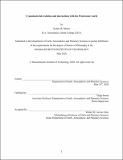| dc.contributor.advisor | Tanja Bosak. | en_US |
| dc.contributor.author | Moore, Kelsey Reed. | en_US |
| dc.contributor.other | Massachusetts Institute of Technology. Department of Earth, Atmospheric, and Planetary Sciences. | en_US |
| dc.date.accessioned | 2020-09-03T17:49:14Z | |
| dc.date.available | 2020-09-03T17:49:14Z | |
| dc.date.copyright | 2020 | en_US |
| dc.date.issued | 2020 | en_US |
| dc.identifier.uri | https://hdl.handle.net/1721.1/127144 | |
| dc.description | Thesis: Ph. D., Massachusetts Institute of Technology, Department of Earth, Atmospheric, and Planetary Sciences, May, 2020 | en_US |
| dc.description | Cataloged from the official PDF of thesis. | en_US |
| dc.description | Includes bibliographical references. | en_US |
| dc.description.abstract | Our understanding of the biosphere prior to the rise of complex life is built largely upon microbial mat structures and some exceptionally well-preserved microbial fossils from the Proterozoic (2500 to 540 million years ago). Some of these exceptional fossils are identifiable as cyanobacteria that were preserved by pyrite, amorphous silica (SiO₂) and other minerals. Although a record exists of these organisms, the sparse nature of fossil assemblages and simplicity of many Proterozoic fossil morphologies makes it difficult to identify specific taxa or create a complete picture of the ancient biosphere and how it interacted with the early Earth. Cyanobacteria are thought to have evolved early in Earth history and played a large part in shaping the ancient biosphere and geosphere, but questions remain about their evolution and the ways in which cyanobacterial communities interacted with the Earth during the Proterozoic Eon. | en_US |
| dc.description.abstract | In this thesis, I seek to build a more complete understanding the record of Proterozoic cyanobacteria, their responses to environmental perturbations and the chemical conditions and microbe-mineral interactions that characterized the Proterozoic marine realm. I begin by investigating the evolutionary relationships between different cyanobacterial lineages and their relationship to chloroplasts. I then analyze an assemblage of pyritized cyanobacteria that were preserved during the Cryogenian and provide a record of primary productivity in the oceans following a global glaciation. Finally, I investigate factors that enabled the fossilization of some exceptionally preserved cyanobacteria and implications of these mechanisms for cyanobacterial biochemistry, chemical conditions, and interactions between microbes and Proterozoic tidal environments. | en_US |
| dc.description.abstract | The combined molecular, fossil and experimental insights allow us to go beyond morphological interpretations of microbial fossils and build a more complete understanding of the evolutionary history of cyanobacteria, the types of cyanobacteria that were preserved during the Proterozoic, the responses of these cyanobacteria to environmental stresses and the interactions of those cyanobacteria with the evolving seawater chemistry. | en_US |
| dc.description.statementofresponsibility | by Kelsey R. Moore. | en_US |
| dc.format.extent | 198 pages | en_US |
| dc.language.iso | eng | en_US |
| dc.publisher | Massachusetts Institute of Technology | en_US |
| dc.rights | MIT theses may be protected by copyright. Please reuse MIT thesis content according to the MIT Libraries Permissions Policy, which is available through the URL provided. | en_US |
| dc.rights.uri | http://dspace.mit.edu/handle/1721.1/7582 | en_US |
| dc.subject | Earth, Atmospheric, and Planetary Sciences. | en_US |
| dc.title | Cyanobacterial evolution and interactions with the Proterozoic world | en_US |
| dc.type | Thesis | en_US |
| dc.description.degree | Ph. D. | en_US |
| dc.contributor.department | Massachusetts Institute of Technology. Department of Earth, Atmospheric, and Planetary Sciences | en_US |
| dc.identifier.oclc | 1191838940 | en_US |
| dc.description.collection | Ph.D. Massachusetts Institute of Technology, Department of Earth, Atmospheric, and Planetary Sciences | en_US |
| dspace.imported | 2020-09-03T17:49:14Z | en_US |
| mit.thesis.degree | Doctoral | en_US |
| mit.thesis.department | EAPS | en_US |
